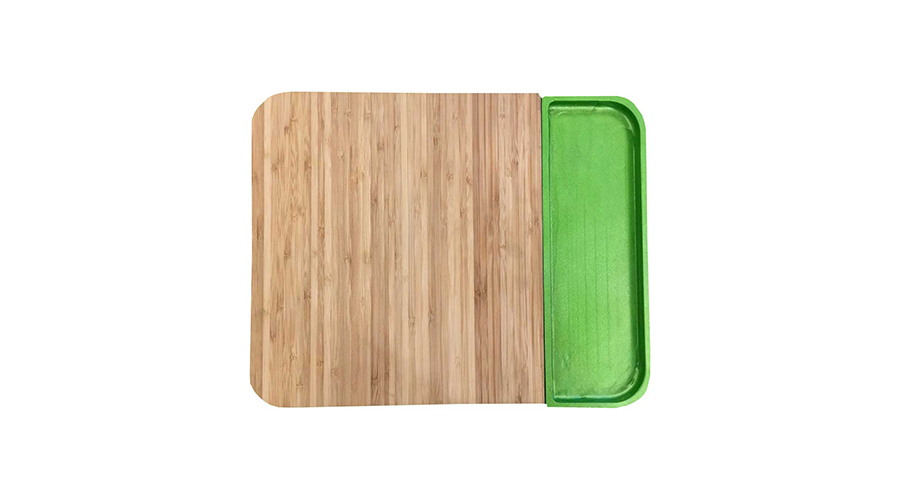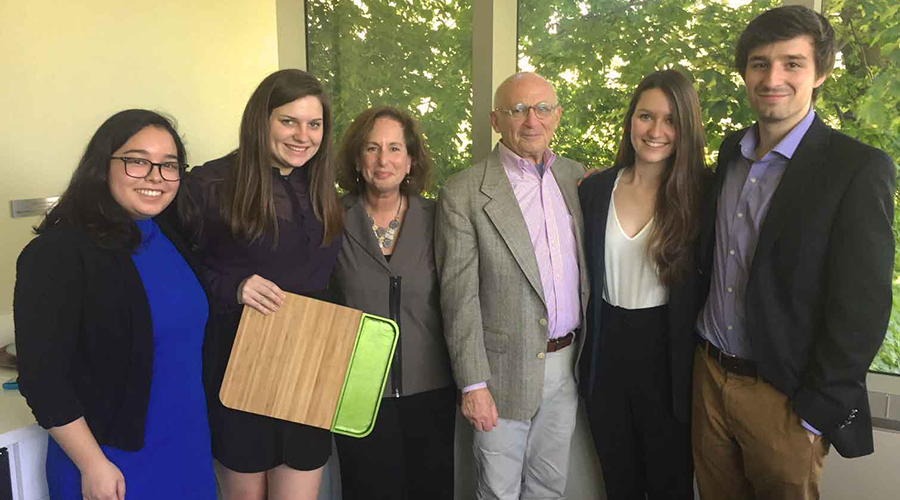FlipA functional design that combines cutting board and storage area
When using a cutting board in a kitchen, individuals come across a variety of problems. Some of these problems include: What do I do with the scraps from what I was cutting? What do I do with the food I just cut? Do I have to dirty another piece of housewares to clear my cutting board? How much food have I cut?
Over the course of ten weeks, a team of four Northwestern Engineering sophomores enrolled in Design Thinking and Communication (DTC) collaborated with Design Lab Home, a Chicago-based business that was founded to explore new opportunities for housewares and products developed by students. The team was asked by Design Lab Home to brainstorm problem areas in the housewares market and create a product that addressed one of those problems. They settled on the specific problem area of cutting and cutting boards.
"It was a great opportunity to really consider the world around us, and how complex the design of everyday things are."
Problem
During the team’s research, they found that home chefs have difficulty using their cutting boards to their fullest potential due to limited countertop space in many kitchens. Existing cutting boards on the market are not sufficient for users looking to optimize space. Many of the products do not address the issue of space at all. Of the products that do address space constraints, they do so by making the cutting surface bulky, which sacrifices space efficiency.
Solution
The team designed Flip. The name comes from a feature of their design: a cutting board with a side storage bin that can double as a cutting board when flipped. The bin allows the user to measure the ingredients as they chop, but it can also be flipped over to provide a larger cutting area if needed.
When preparing vegetables and fruit for cooking or eating, there are often scraps that remain or the user runs out of space to store their cut items. Flip offers a space for the user to cut their food and push the items they are saving or discarding into a storage bin. Flip provides the home chef an outlet to become an expert at mise en place, or “putting everything in place,” while simultaneously allowing them to utilize all of their cutting space.
The team used bamboo as the wood section of the cutting board because it is a hygienic wood that provides stability and durability. For the side storage bin, they used lime-green polypropylene, a material that can be cut upon as well as easily store food.
Development Process
To begin, the team had a meeting with their partner from Design Lab Homes. At the meeting, the students learned about the market for houseware products. Design Lab Homes team gave the following requirements for the project:
- Price: The product must be manufactured to be sold at or less than $29.99.
- User Safety: Product should be safe to use. Careless use should not pose harm or cause injury.
- Ease of use: The design must be easy to use and its use must be intuitive. Moreover, it must be easy to clean.
- User Experience: The design must be compact. The design must be dishwasher safe and food safe. The design must be aesthetically pleasing. The design must be durable.
- Originality: The design must not infringe upon current intellectual property patents.
Afterward, the team conducted background research to understand the market that their whitespace product would enter. After researching the housewares market, its consumers, and competitive products, they decided to concentrate on ease of use, patentability, and compactness of the design.
Next, the team conducted user observation with a sophomore student at Northwestern. The team observed the user making a meal in a kitchen while interviewing him and taking photos of his progress as he cooked. Based on this user observation, the team identified the following user priorities for their design: utilize small space better than current housewares items; ease of use; “sleek” design; and multifunctional.
The team created three mockups and then conducted user testing to determine the final direction for their design. They conducted eleven individual interviews and asked the users to evaluate each mockup for overall appearance, usability, and bulkiness. The team observed the users handling the cutting board as if they were using it in the kitchen to chop food.
The results from the user testing led the team to choose to make the bin the width of the cutting board to allow users to easily scrape food into the bins. They also chose to limit the bin’s size to a quarter of the total cutting board size in order to achieve a desirable ratio of bin space to cutting space.
To connect the bin to the cutting board, the team chose a keyhole locking mechanism that provides a strong connection while requiring minimal movement to disconnect the parts and flip over the bin. The team decided that this option was preferable to magnets, which could have interfered with metal knives or not provided a strong enough locking to hold the two components together.
To manufacture Flip, the team worked in the Segal Prototyping and Fabrication Lab. For the tray, they took a block of ABS plastic, milled out the center, milled a radius around the inner edge of the tray, rounded the corners, and sanded the surface. To make the tray the correct shade of green we used primer and spray paint. For the bamboo portion of the cutting board, team members cut the board to size, rounded the corners, and sanded everything. The team manufactured a screw and drilled into the tray. They then milled a small hole into the bamboo and created an aluminum covering. These two steps served as the keyhole locking mechanism.
Faculty advisersEllen Blum-Barish, Walter Herbst
ProgramDesign Thinking and Communication (DTC)



